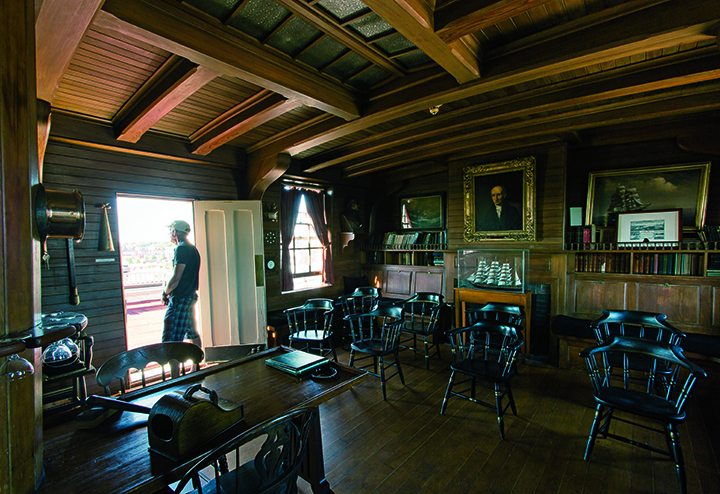On the top floor of the Hawthorne Hotel in Salem, Massachusetts, is a once-secret room soaked in the legacy of the sea and the ships’ captains who sailed into history.
[slideshow post_id=”554455″]
On Columbus Day weekend 2013 my friend John Wigglesworth meets me in downtown Salem, Massachusetts, outside the historic Hawthorne Hotel. He’s taking me to the “Ship’s Cabin,” a replica from the bark
Taria Topan (one of the last Salem vessels to trade in the East Indies) and the little-known home of the city’s oldest organization, the Salem Marine Society.
John leads me through the Hawthorne’s luxurious lobby to a guests’ elevator, where he hits the number 6 for the hotel’s top floor. From there it’s a long walk to the opposite end of an Oriental-carpeted corridor, through an unmarked door with frosted-glass panes, and up a steel-railed stairwell to a concrete landing. John waves a magnetized card in front of an armed reader. The door opens.
I’d heard whispers about this room for years. But I was unprepared for the time-travel jolt of walking out of a hotel stairwell and into an actual ship’s cabin. The room is lit with hurricane lanterns and paneled in teak. Cypress “hanging knees” brace overhead timbers; brass instrument dials and solemn portraits stud the walls. The dark-wood ceiling is cambered, or arched, as if a water-shedding weather deck lay directly above. A massive deck-stepped mast rises centrally. The detail is so authentic—the 1925 collaborative effort of Captain Edward Trumbull and hotel architect Philip Horton Smith—that Society members were recently informed that if they wanted an appraisal they’d better find a marine insurer.
“All this dark wood,” John exults. “It’s just got the feeling of a 19th-century cabin!” A tall-ship sea captain and the 881st member of the Society, John is the great-great-great-grandson of the fabled Salem navigator Nathaniel Bowditch, member number 308. What he and his fellow members adore about the room is the direct, living connection to Salem’s maritime heritage. There are several formal portraits (including a large one of Bowditch), a prized collection of sextants, and an oversized members’ book with profile pictures dating back to the Society’s pre-Revolutionary beginning. An interior door leads to the hotel roof (or “ship’s deck,” in the members’ vernacular) and a bird’s-eye view of Derby Wharf, Salem Harbor, and the outlying islands.
The Salem Marine Society formed in 1766 in an age when a fair proportion of local commanders disappeared at sea. The group’s charitable mission was to afford relief to the families of deceased members and to expand an area of knowledge that bore directly on their survival, ocean navigation.
The Society’s preserved ledger books record the origins of the group and much else, but little detail survives of how and why the Ship’s Cabin came to be built. What is known is that the group used to meet in the Society-owned Franklin Building, the structure preceding the Hawthorne. In the 1920s they sold the property but stipulated, thanks to Captain Trumbull, that the builders include the Ship’s Cabin atop the new building. One can only imagine that magic moment when the hotel’s architect looked across the table at his willful counterpart and had to have said, “You want to build
what, where?”
John shows me one of the room’s most beloved possessions: an 18th-century wooden voting box holding white marbles and black cubes. During new-member votes, a chosen white marble affirms; a “blackballing” black cube opposes. Those who’ve heard it swear that the black cube makes a chillingly hollow sound when dropped into the box’s secret compartment. The “master” at those meetings—the Society’s chief officer—wears a silver anchor around his neck and keeps order with a “fid” gavel (a tapered wooden club ordinarily used to splice rope). Current master Ben Shreves says he could do without a literal anchor around his neck but dutifully abides by the custom.
A landlubber like myself loves that sort of history—and the fact that we’re on six solid floors of hotel (and not the angry Atlantic) while discussing it. Dan Finamore, maritime curator of the Peabody Essex Museum, loves it, too. His collection at the museum features 200 artifacts from past members. He says that the room is so impressive that he regularly invites visiting maritime historians and benefactors to join him in it. “They’re just bowled over,” he says. “Absolutely amazed.”
Finamore is an honorary member, one of only nine currently (there have been 25 over the years). The other routes to membership—and regular room visitation rights—are maritime achievement and legacy. Originally the only people allowed into the Society were “deepwater” sea captains who had completed a full voyage. Those days are gone, of course, and to survive, the Society has periodically amended its restrictive bylaws. In 1790 it allowed in ships’ owners; by 1994 it had from time to time begun inviting sons, grandsons, great-grandsons, and eventually female descendants of members, as well as past and present ship owners and masters.
The Society was never open to just anyone, but the novelty of the Ship’s Cabin has sometimes drawn surprise visitors. Perhaps no visit has been as awkward as that of a Virginia historical group in 2006. Their tour took an unexpected turn when “horrified” members discovered that the portrait of native son Matthew Fontaine Maury had been hung reversed and “head down”—the Society’s response to the brilliant oceanographer’s siding with the Confederacy. A plaque beneath the portrait branded him a traitor. The Virginians appealed for an immediate pardon, noting the long passage of time, but the Society staunchly refused. Newspapers chronicled the episode, describing it as the last chapter of the Civil War and propelling the Society and the Ship’s Cabin into the consciousness of many Salemites for the first time. “Everybody knows about Salem and the witches, but I guess that was one of the first times people heard about us,” John recalls.
The Society made peace with the Virginia folks in 2008; it added a second portrait to offset the disgraced first. But, perhaps more important, the incident spurred popular interest in the Society and its room. Work that had gingerly begun in the early 1990s to open up the Society picked up steam. A new plaque in the hotel lobby identified the Ship’s Cabin for the first time as “our rooftop treasure,” and the general public was invited to take tours during the regional “Trails & Sails” celebration in the fall (this year, set for September 19–21 and 26–28).
After 248 years, it seems that the Society is on the verge of a new golden age of sorts, also rooted in discovery. Of course, the beauty is that the discovery isn’t a world away but right in front of everyone. As my friend John notes with a big grin, “Who’d ever know there’d be a room like this at the top of the Hawthorne?”
At press time, details on this year’s Ship’s Cabin tours were not yet available. Check for updates this summer at: hawthornehotel.com and essexheritage.org/ts









This was a great article that should have been written in the past (not present) tense, as your experience happened LAST year.
What a startling surprise for a Salem native, ( born in 1939 ) with family roots going back to the early 19th century. We have extended family scattered all around Salem from Forrester Street, Barnes Avenue, Surry Lane stretching out to Goodell Street with a family cemetary at St. Thomas Church……The PIECEWICZES, proud polsh decendents. I am a sailor, but without deep Maritime roots…….To visit the ” Ship’s Cabin ” would be an honor and a sincere priviledge.
Edward Trumbell is the great-uncle of my father, Frederick Thomas. He had told me that there was a model of the Taria Topan at the Mystic Seaport. I was told yesterday that it was perhaps in their research facility. Is there a model ?